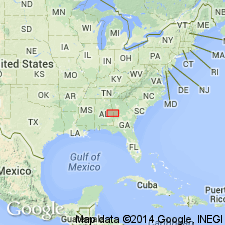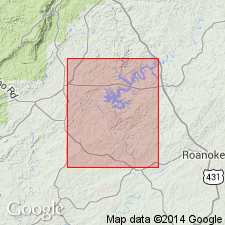
- Usage in publication:
-
- Almond granites
- Almond plutons
- Modifications:
-
- First used
- AAPG geologic province:
-
- Piedmont-Blue Ridge province
Summary:
Eleven pod-shaped granitic stocks occur within the Wedowee Group, the largest near the community of Almond, AL, and the name Almond Granites is applied to these stocks for field-mapping purposes. The stocks may intrude the Wedowee or represent pinnacles of basement upon which the Wedowee was deposited. There is no evidence of contact metamorphism. The Almond plutons vary in composition from leucocratic granites to mesocratic quartz diorites. Mineral composition is oligoclase, microcline and muscovite, with biotite the common mafic mineral and epidote occurring locally. Accessory minerals include apatite, sphene, garnet, and zircon. The plutons display a unique texture caused by oriented muscovite inclusions in the plagioclase.
Source: GNU records (USGS DDS-6; Reston GNULEX).

- Usage in publication:
-
- Almond Trondhjemite
- Modifications:
-
- Named
- Dominant lithology:
-
- Trondhjemite
- Granite
- AAPG geologic province:
-
- Piedmont-Blue Ridge province
Summary:
Almond Trondhjemite is here named in east-central Alabama. Referred to as Almond granites by Bentley and Neathery (1970). Unit occurs as scattered phacoliths, sills, dikes, and plutons. Intrudes Wedowee Group rocks. Described as light-gray to locally white leucocratic trondhjemite, containing abundant muscovite and locally biotite and epidote; typically fine- to medium-grained, locally foliated. Age is Mississippian and Pennsylvanian.
Source: GNU records (USGS DDS-6; Reston GNULEX).
For more information, please contact Nancy Stamm, Geologic Names Committee Secretary.
Asterisk (*) indicates published by U.S. Geological Survey authors.
"No current usage" (†) implies that a name has been abandoned or has fallen into disuse. Former usage and, if known, replacement name given in parentheses ( ).
Slash (/) indicates name conflicts with nomenclatural guidelines (CSN, 1933; ACSN, 1961, 1970; NACSN, 1983, 2005, 2021). May be explained within brackets ([ ]).

